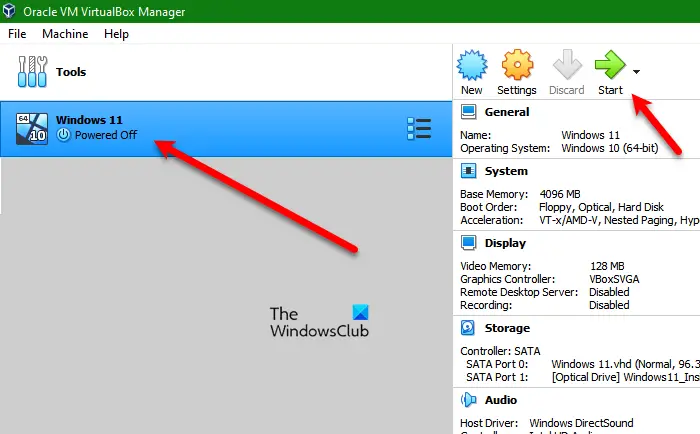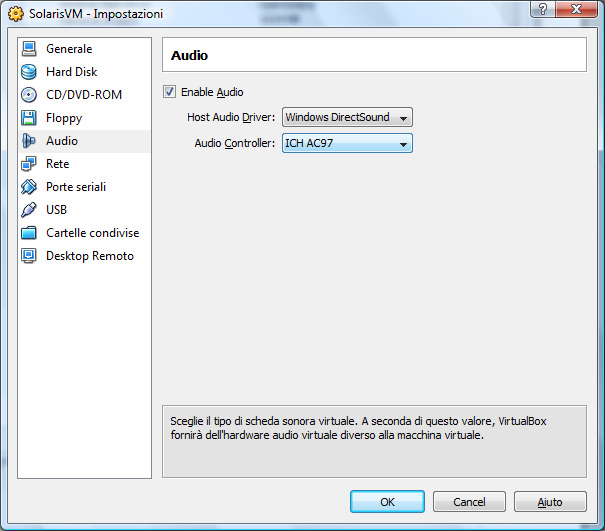
- #VIRTUALBOX WINDOWS DIRECTSOUND DRIVER HOW TO#
- #VIRTUALBOX WINDOWS DIRECTSOUND DRIVER MAC OS X#
- #VIRTUALBOX WINDOWS DIRECTSOUND DRIVER INSTALL#
- #VIRTUALBOX WINDOWS DIRECTSOUND DRIVER DRIVERS#
- #VIRTUALBOX WINDOWS DIRECTSOUND DRIVER PC#
This allows the client to treat a filter graph as a single filter, thereby avoiding complexities of graph management such as inter-filter communication. When asked by a client to instantiate a particular pin on a virtual device, SysAudio constructs the graph automatically and manages the graph's internal pin connections transparently to the client.
#VIRTUALBOX WINDOWS DIRECTSOUND DRIVER DRIVERS#
Adapter drivers should not register themselves in this category.Ī SysAudio client can treat a filter factory for a virtual audio device similarly to a filter factory for a hardware or software component. SysAudio reserves the registry category KSCATEGORY_AUDIO_DEVICE exclusively for its virtual audio devices.
#VIRTUALBOX WINDOWS DIRECTSOUND DRIVER HOW TO#
The KsStudio utility in the Windows Driver Kit (WDK) is an example of an application that bypasses SysAudio and allows users to construct filter graphs manually.įollowing PnP device enumeration, SysAudio takes stock of the registered audio hardware and software components in order to determine how to construct the various audio filter graphs that its clients might require.Īfter determining the list of filter graphs that it can build from the available hardware and software components, SysAudio registers these graphs as virtual audio devices for playback, recording, MIDI input/output, and mixing. SysAudio's clients include DirectSound and the WDMAud system driver, which serves as the interface between WDM audio drivers and the audio-specific Microsoft Windows Multimedia APIs waveIn, waveOut, midiIn, midiOut, mixer, and aux (described in Microsoft Windows SDK documentation). The system audio driver (SysAudio) uses the available hardware and software components to determine the filter graphs to build.įor more information about the system audio driver, see SysAudio System Driver. Linux guests: suppress setuid and setgid in shared folders.Virtual audio devices represent the filter graphs that render and capture audio content. Linux guests: fixed black screen when 3D enabled in guests. The operating system settings are: Host Driver:Windows DirectSound. Windows guests: fixed incorrect function error when using shared folders in certain appli-cations. I installed Fedora 18 Xfce Spin as a guest operating system on VirtualBox.It has no sound. Windows hosts: fixed indiscriminate binding of NDIS5 bridged driver, that caused PPPOE malfunction. 3D: add environment variable to configure presenting 3D content on main thread. Network: Added a workaround for older guests which do not enable bus mastering for the virtio PCI device.

Network: fixed PXE boot regression in e1000. Storage: fixed handling VMDK images created by Amazon EC2 VM export. Storage: fixed overwriting certain INQUIRY data for the DVD/CD drive attached to a AHCI controller.
#VIRTUALBOX WINDOWS DIRECTSOUND DRIVER INSTALL#
Serial: fixed an issue where the serial port parameters in the emulation and host serial port got out of sync. Some Windows 10 users are having issues with the video driver for VirtualBox when they try to install Windows 10 on it. Unfortunately, version 5.1.28 introduces an unrelated problem with networking that makes the VM largely unusable.

So, in my specific case, the issue looks to be resolved. The new driver is dated with version number 6. Audio: various fixes for Windows guest surround setups. This driver is a couple years newer than the one I was using when I reported the issue. Video recording: added better file seeking support and fixed playback of recorded files with certain players (e.g. Audio: various fixes for the DirectSound backend. Audio: added support for distinguishing recording sources in the PulseAudio mixer on the host when multiple VMs are running.

Front end: fixed crash while opening New machine wizard. Front end: Linux: fixed seamless regression caused by wm_class functionality. Front end: Linux: prevent VM window from jumping and auto-resizing to tiny size after resizing it on HiDPI screen. VMM: fixed EMM386 issue with detecting suitable page frame base. The following items were fixed and/or added: VMM: added support for FSGSBASE, PCID, INVPCID CPU features for guests. There is the possibility to install Linux on a virtual machine on Windows and vice versa.
#VIRTUALBOX WINDOWS DIRECTSOUND DRIVER PC#
In the genre, several solutions are known for their ease of use, such as VMware Workstation, Parallels Desktop or Microsoft Virtual PC 2007 SP1.Ī virtual machine is a useful way to use two operating systems simultaneously and harmless to the host computer. Virtualization solutions allow installing an operating system on a virtual machine using the resources of the host PC, thus enjoying very good performance. It also includes a remote access via HTTP protocol, convenient for demonstrations on a clean system. The ability to manage multiple states of the system is particularly interesting and its interface is very simple.
#VIRTUALBOX WINDOWS DIRECTSOUND DRIVER MAC OS X#
as host, Mac OS X missing the call as a guest. Called hypervisor, the application supports Windows OS X, Linux, Mac, Solaris, FreeBSD, etc. VirtualBox offers virtualize your operating system (OS) guests on a host machine. VirtualBox is an easy and elegant solution for those who want to control a computer from another computer.


 0 kommentar(er)
0 kommentar(er)
